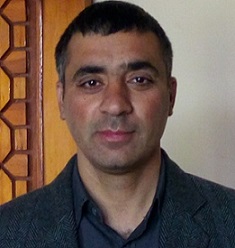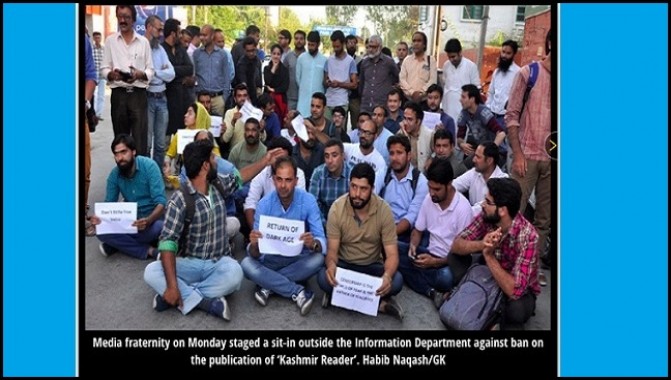Kashmir and India: parallel universes

Hilal Mir
Before I express myself on why the government, propelled by nationalistic fervour so strong as to drown out every form of dissent and protest, did not execute the proposed daylong ban on NDTV India in the face of widespread outrage and yet continues the one-and-a-half-month-old ban on Kashmir Reader, it is necessary to state some facts.
On Gandhi Jayanti, five policemen delivered the Srinagar district magistrate’s order asking us and a few printing presses to stop publication of Kashmir Reader immediately. The ban order rides on a colonial law and states that the publication of the newspaper might incite people to violence. It invoked section 144 CrPC, Section 3 of the Incitement of Offences Act and Section 10 of the Press and Publication Act.
To back the order, various departments have prepared a thick dossier of what appear to be the charges against us. We were not given a copy of the dossier but Kashmir Reader owner and editor-in-chief, Haji Hayat, has been offered a glimpse into the five-page summary of the dossier.
In an interview with a Srinagar-based weekly, Kashmir Life, Hayat said the dossier included the publication of an article by Palestinian columnist Ramzy Baroud, the headlines of some of our editorials and reports, a few news stories and columns, and a generalized displeasure at the perceived anti-state policy of the newspaper.
Now, none of these charges match the charge against NDTV India, which is that of “revealing strategically-sensitive details” of the Pathankot air base when it was attacked on January 2. Yet, we have been banned for six weeks while NDTV India has been rightly spared a 24-hour blackout.
Why the different treatment? Because the charges against the two media outlets cast them in two entirely different frameworks: Kashmir Reader becomes the evil, anti-national newspaper while NDTV India is being careless. That is probably why the Editors’ Guild of India, while asking Chief Minister Mehbooba Mufti, to “reconsider the ban on Kashmir Reader” patronizingly put the onus on ‘editors to uphold the best journalistic standards of fairness and balance while publishing news’.
The Guild’s statement on the NDTV India ban, however, explicitly asked the government to rescind the decision and did not dish out any side lesson on journalism either.
In an atmosphere where Arnab Goswami appears on TV screen like a sonic boom and accuses some journalists, especially those who annually sit with soldiers at borders as a mandatory patriotic ritual, of being sympathetic to “anti-nationals and splittists”, it is perfectly natural that Kashmir Reader only can only expect the guillotine, not solidarity.
While almost all Indian media organisations share a common vision about Kashmir, ie., it is an integral part of India and Pakistan is the troublemaker, competition drives them to outdo each other in subverting the ground reality in the Valley. So, none of them want to be seen as siding with a newspaper that has been dubbed a troublemaker. The facts do not matter.
Early this year, a controversy arose over a proposal to build residential apartments in the Valley for retired soldiers. Kashmir Reader had carried the story last year and, following a similar story by the Indian Express, we did a follow-up story. The reporter is still in possession of the minutes of the meeting, chaired by the governor, where the proposal was mooted.
The state government first termed the Kashmir Reader report baseless and then, bizarrely, told a press conference how the previous government had forwarded the proposal. When the entire edifice of governance and democracy rests on farce, impulse trumps facts.
Similarly, if only the Editors’ Guild of India had visited the Valley during the initial days of the uprising, it would have noticed how Kashmiri journalists were being beaten up by angry protesters for the lies and concoctions that were being broadcast from news studios in New Delhi.
One news channel ran the preposterous claim that protesters were being paid Rs 500 for snatching a rifle from policemen and soldiers, Rs 1000 for snatching a grenade and Rs 5000 for organizing a protest. Common sense tells you that it is easier to organize a protest than to snatch a rifle, the riskiest act. The reward for snatching a rifle should therefore be the highest.
Such reportage was actually inciting people to violence in Kashmir. But no media watchdog or organization in India took note because such lies score the highest on the patriotic scale.
Kashmiri local media and majority of the media in India report two entirely different worlds when they report Kashmir. It won’t be an exaggeration to say that a consensus emerged rapidly among Indian media outlets, especially the broadcast media, that the uprising in Kashmir was the handiwork of people sitting in Pakistan.
Even those who saw it for what it was - a massive, spontaneous, rural uprising against the killing of a popular militant commander - tried to slip state propaganda into their watered down reportage of the ground situation. The Indian media is at a safe distance from the daily gaze of the people in Kashmir. It can afford distortions. While some distinguished Indian journalists can openly voice their views on Kashmir and make recommendations to the security agencies from TV studios, Kashmiri journalists can be gagged and tagged seditious for their political beliefs.
A study, Media Propaganda and the Kashmir Dispute: A Case Study of the Kashmir Floods (Reuters Institute) by journalist Wasim Khalid, based on content analysis of reports published in the Times of India and broadcast on NDTV in the week immediately after the floods, revealed that “New Delhi-based media coverage was overwhelmingly in favour of the Indian government and armed forces.”
It said: “The Times of India devoted more than half (57%) of its coverage specifically to the army’s relief efforts and NDTV focused almost entirely (97%) on the role played by the army and the government in the crisis. Both outlets appear to have ignored the contribution made by local Kashmiri volunteer rescuers. Indian media coverage was also notably security-centric, possibly to create sympathy for the Indian army, typically viewed as an occupying force in the region.”
If a natural disaster can become a security-centric spectacle, imagine that kind of reportage a massive anti-state uprising would evoke? Which outlet has carried the widespread denunciation by the Kashmiri business community and civil society of the government’s theory that black money and fake notes has sustained the uprising? With demonetization ending it overnight?
Countless examples can be cited to show that the subversion of reality in Kashmir by the majority of Indian media outlets has rendered an interface - and hence solidarities - very difficult, if not impossible.
However, it must be noted that a large number of journalists in India, in their individual capacities, still resist the nationalistic hype and take a nuanced view of the situation. This is especially true of the print media. The Indian Express, Firstpost, and Southlive were kind enough to carry my pieces on the ban.
Kashmir Reader, therefore, was constrained to place its reliance entirely on the local media for support. The newspaper still believes that better sense will prevail on the state government, especially in the wake of a recent statement by Ms Mufti that the current situation can best be addressed by following her late father, Mufti Mohammad Sayeed’s, vision.
She has told a group of editors who met her over the Kashmir Reader ban that she will look into it and that her father would not have liked the gag on the newspaper. She did not specify a date by when it would be lifted.
Lifting the ban would certainly be a small but significant step in the implementation of her father’s vision for the state.
